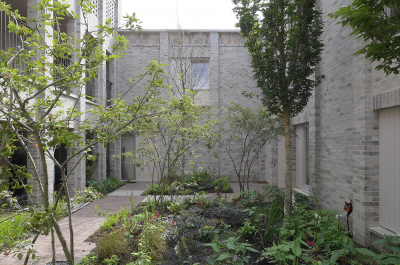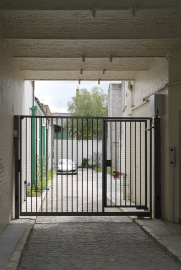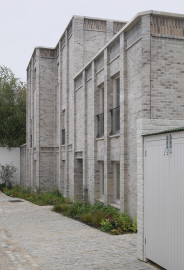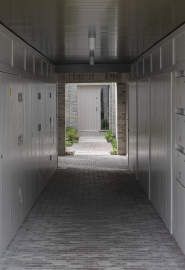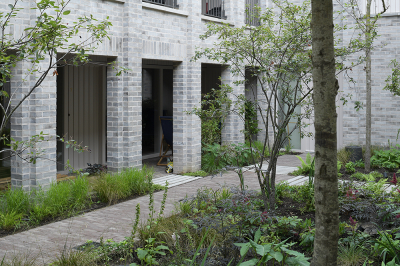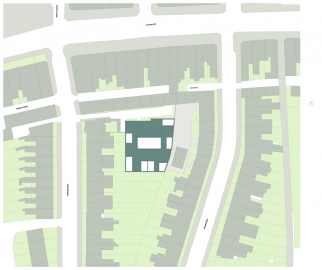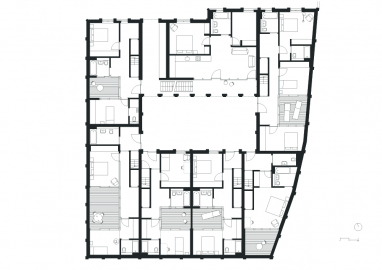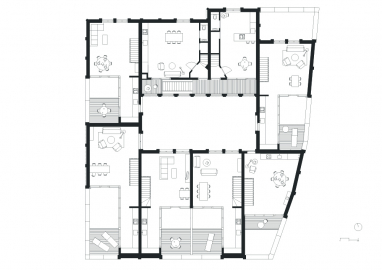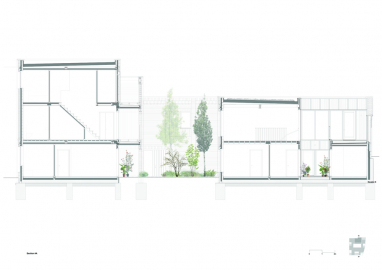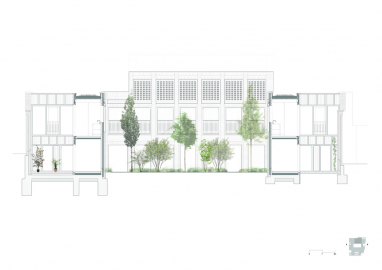Courtyard housing
Tucked away within an urban block and only partially visible from the entrance gate, nine apartments are organised on two floors around a communal garden on the site of a former industrial workshop.
The project is a case study in the re-appropriation of a residual brownfield site to house a small-scale urban community of apartments available for rent.
Bounded by terraced houses, the triangular site which once housed a sheet metal workshop is accessed through an arch and inner mews. This gives it a secluded character, despite proximity to a busy street.
Nine dwellings ranging in size from 65 to 105m2 are accessed from the courtyard garden and arranged around a private courtyard space, with a timber-decked terrace on the first floor. Bedrooms are on the lower floor level, with windows opening onto private courtyards. A staircase leads to the first floor living spaces, open to daylight and views.
Generally two-storey-high, the building rises to three on the northern side, with an imposing stepped facade to the mews. On the courtyard side, a metal stair leads to a first-floor open loggia overlooking the garden, attenuating the building’s scale. Flat roofs planted with sedum and hardy flowering plants create a green micro-habitat.
The spatial strategy for the project was generated by the enclosed nature of the site, surrounded by houses and gardens, with limited daylight penetration, particularly at ground floor level. The courtyard garden at the centre of the building fills the site and becomes the focal point for residents, a communal amenity space where neighbours can meet, from which dwellings are accessed. Linked to the quiet mews to the north by a timber-lined passageway, the ensemble has a communal character and offers natural surveillance. Inside and outside spaces merge in an informal way across various thresholds and levels.
The garden is densely planted with multi-stemmed fruit trees, deciduous and evergreen shrubs and grasses, perennials and climbers. As flowers bloom and fade, tree canopies fill out and shed their leaves with the changing of the seasons and shrubs spill over pathways over time, the garden mirrors the comings and goings of the small community of residents, inviting them to linger, chat with neighbours, sit with a cup of coffee or a book. Clay brick pathways lead to apartments’ front doors, where an area big enough for a couple of chairs can be used in the manner of a stoop.
The dwellings have high ceilings with exposed joists, terracotta and oak floors and painted timber wall panelling, evoking the Victorian industrial heritage of the site rather than conventional domestic architecture of the surrounding terraces. The arrangement of glazed screens and terraces creates a light, fluid sequence of internal and external rooms. Vertical pilasters subdivide the facades, lending them classically elegant vertical proportions, while twisted soldier course friezes and lintels have an ornamental quality that evokes the solidity and permanence of the robust warehouse-like industrial architecture of the past. The light grey slop-moulded brick used for all external walls has an engobe finish – a coloured slip applied to the brick before firing which results in a variety of tints. Combined with a flush mortar joint, this gives the walls a handmade texture accentuated by changes in daylight. Windows and infill cladding elements are of light-grey stained timber, while the twisted metalwork of the balustrades references the cast-iron railings of the domestic architecture of the area.

